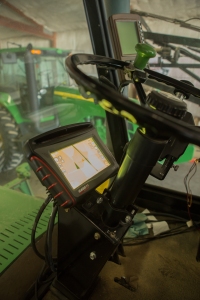Question: What is “precision agriculture” and why is it important?
Answer: Precision agriculture is one of many modern farming practices that make production more efficient. With precision agriculture, farmers and soils work better, not harder.
A better name for precision ag might be “site-specific ag”. Growers are able to take large fields and manage them as though they are a group of small fields. This reduces the misapplication of products and increases crop and farm efficiency.
It has been said farmers were the first land stewards. They use research about weather patterns, soil temperature and humidity, growth, and other factors. They rotate crops to improve diversity, and monitor irrigation rates so that salts do not accumulate. They also use precision agriculture practices to apply nutrients, water, seed, and other agricultural inputs to grow more crops in a wide range of soil environments. Precision ag can help farmers know how much and when to apply these inputs.

There is a lot of technology used to make modern agriculture more efficient. For example, some farmers use global positioning systems (GPS) and GPS-computer guided tractors and harvestors. Other geo-referenced site-specific practices may include:
• electromagnetic soil mapping
• soil sample collection
• crop yield data collection
• aerial imagery
• crop or soil color index maps
• soil types
• soil characteristics
• drainage level
• potential yields
Each of these geo-referenced data layers helps subdivide a large field area into smaller management zones. Using small management zones reduces waste while increasing production potential.
One example of a precision agriculture practice is to evaluate the natural soil variability of a field. If the soil in one area holds water better, crops can be planted more densely and irrigation can be sparing. Or, if the plot is used for grazing, more cattle can graze than a similar area of poorer quality soil.
By studying these factors and using precision agriculture, farmers are able to produce more food at a fraction of the cost. Farmers also conserve soil for sustainable food production. Precision ag results in a stable food supply, which results in a strong community.
Answered by Aaron DeJoia and Matt Duncan
To learn more, view SSSA’s Soils Support Agriculture video. Watch a video about Precision Ag researcher Ray Asebedo.
To receive notices about future blogs, be sure to subscribe to Soils Matter by clicking on the Follow button on the upper right! Explore more on our webpage About Soils. There you will find more information about Soil Basics, Community Gardens, Green Infrastructure, Green Roofs, Soil Contaminants, materials for Teachers and more.
More educational materials can be found on various SSSA websites:
http://soils4teachers.org/ (K-12 Lesson Plans and Activities)
http://soils4kids.org (Just for kids!)
http://soils.org/iys (International Year of Soils, with a coloring book and monthly ideas for teachers and scientists!)

Very helpful use of modern technology which can be easily adopted by the farmers with little efforts.
Precision farming (agriculture) is a very significant application of GPS .But in the developing countries like BANLADESH , GPS system is not enough available . Then Its functions is also mostly unknown .In this case What should we do for Precision Agriculture ?
From Aaron DeJoia: A good example of good soil and agronomic science that all farmers should be using is the 4Rs for nutrient management. Using the 4Rs for nutrient management can improve nutrient use efficiencies of the crop while reduce potential negative environmental impact of nutrients being transported to surface or groundwater. The 4Rs are:
Right Time – Application of nutrients at the right time is critical to ensure that plant nutrients are applied as close to the crop needs as possible and decreases potential losses to the environment.
Right Place – Applications of nutrients placed in the right place increase nutrient use efficiency by the crop and minimizes potential movement of nutrients to the environment.
Right Rate – Application of nutrient sources at the right rate increases nutrient use efficiency while providing greater return to the farmer. The right nutrient rate does not always mean less application but results in using the nutrient resource to its fullest potential and reduces nutrients that are lost to the environment.
Right Source – There are many different types of fertilizers on the market for farmers to use. Choosing the correct nutrient source can provide cost saving while decrease potential nutrient loss to the environment.
why can’t small farmer and marginal farmer adopt this modern technology of farming???
pls give reply
Dear Shivkumar, thank you for reading our blog. This question is much beyond the scope of our scientific blog. Please look up ECHO farm https://www.echonet.org/ They actually have many solutions for smallholder farmers. SF
Thanks for using us as a reference, and happy blogging! SVF